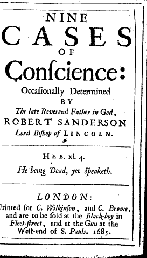| |

|
E210
| Casuistry, Conduct & Clarissa | Winter 2010
Casuistry, dependent on a complex understanding of
conscience, is a case-based method of solving particular moral
problems in light of known moral principles.
The problem to be solved, known as a “case of conscience,” can range from whether to take an oath (when the stakes
were very high), to whether it’s ok to buy something you think
may be stolen, to whether a father can command a child to
marry. Although there are some well-known casuistic texts
(see, to the left, Sanderson’s 9 cases [posthumously published 1685]
which as we will see can seem like fictional pre-texts, casuistry
itself produces not a text but a process and thus a “habit
of mind” and potentially a route into the mind. Like casuistry
guides and compilations, conduct books such William Fleetwood’s
The relative duties of parents and children, husbands and
wives, masters and servants, consider’d in sixteen sermons:
with three more upon the case of self-murther (1705), were
guides to appropriate conduct and were akin to an ancient
literature of duties, principally Cicero’s De Officiis. Conduct
books set out to mold behavior, but they are only steps away
from misbehavior. There is a huge bibliography on the relation
between novels and conduct books, but we will move our questions
back to an examination of the mind making decisions. Clarissa’s
“life” is constructed of one case of conscience after another.
**SPOILER ALERT**
No one imagines that Clarissa is a plot-based novel,
but if you have never read it, don’t let anyone tell you what
happens. And paste a piece of paper over the back cover of
the Penguin edition. If you have read it, please be courteous
and let others read themselves into “what happens.” Eighteenth-century
readers heard rumors (and one wrote to Richardson begging
him to change his mind about the plot, but all had to wait
6 months between each of the 3 parts to find out “what happened”).
Course
Information || Useful Materials || Paper Page || Mail Archive ||
Messageboard ||
|
| |
DATE
|
In
class today
|
Supporting
Materials
|
Wk. #1: Wednesday,
1/6
|
Introduction
to course: Circumstances alter cases.
Examples of cases of conscience (from EEBO): Joseph Hall || Jeremy Taylor || Richard Baxter
Historical sketch || 1649-1714||The House of Stuart || Trial of Charles I ||
The Ubiquity of the "case of conscience": from the Engagement Oath to Susanna Wesley's problem with Samuel.
Pamela and Richardson's Familiar Letters|| Letters CXXXVIII & CXXXIX
Pamela & her Problems
Introduction to EEBO & ECCO
|
CHARLES I & CROMWELL STATUES LONDON - Youtube || King Charles I -Youtube || King Charles II - Youtube ||An Act prohibiting the
proclaiming any person to be King|| Declaration of Breda || Clarendon Code || Exclusion Bill || Toleration Act || Act of Settlement || Act for Preventing Occasional Conformity ||
Try looking up case, casuistry, conscience, and other key terms in the OED.
The Oxford DNB will also often be useful.
|
|
Wk. #2. Wednesday,1/13
|
Casuistry cases: Nine cases of conscience occasionally determined by Robert Sanderson. , London : Printed for H. Brome, J. Wright, and C. Wilkinson, 1678.
Keith Thomas, "Cases of Conscience in Seventeenth-CenturyEngland" (Cameron Aroz)
George Starr, "From Casuistry to Fiction" (Cristina Rodriguez)
Samuel Richardson, Clarissa, to p. 250.
For the Message Board: Is the "case of conscience" still an active ethical framework?
There are also message board forums for Clarissa & Sanderson's Cases. |
Sanderson's cases
- I. Of Marrying with a Recusant 1
- II. Of Unlawful Love 11
- III. Of a Military Life 40
- IV. Of Scandal 75
- V. Of a Bond taken in the King's Name 82
- VI. Of the Engagement 88
- VII. Of a Rash Vow 114
- VIII. Of the Sabbath 137
- IX. Of the Liturgy 157
Bishop Sanderson's Lectures on Conscience and Human Law (Google)
Sanderson in DNB
New Athenian Oracle Index Page
On Elizabeth Carter, whose "Ode to Wisdom" Richardson used in Clarissa, without permission |
Wk#3. Wednesday,
1/20
|
Camille Slights, "The Tradition" & "Method as Form" in The Casuistical Tradition in Shakespeare, Donne, Herbert, and Milton (George Zhu)
Albert R. Jonsen & Stephen Toulmin, The Abuse of Casuistry
Part I: Background (Cameron Aroz)
Part II: The Precursors (Regan Norris)
Clarissa, to p. 350 (volunteer)
AJVS: presentation of paper topic possibilities
|
Reviews of The Abuse of Casuistry |
Wk#4. Wednesday,
1/27
|
The Abuse of Casuistry [postponed]
Part III: High Casuistry (volunteer)
Part IV: Three Samples of Casuistry (volunteer)
Part V: The Crisis. "Casuistry Confounded: Pascal's Critique" (general discussion)
JUST Clarissa, to p. 650. |
|
Wk. 5. Wednesday,
2/3
|
JUST Clarissa to p. 950. |
|
|
Wk#6. Wednesday,
2/10
|
Josephine Donovan, "Circumstances Alter Cases: Women, Casuistry, and the Novel" from Women and the Rise of the Novel, 1405-1726. (Anjali Parasnis-Samar )
Tom Keymer, "Reading epistolary fiction" (George Zhu)
Tom Keymer, "Casuistry in Clarissa: The first installment, December 1747," (Matt Mieskoski)
(ch. 1 & 2 from Keymer's Richardson's Clarissa and the Eighteenth-Century Reader.
Start reading William Fleetwood’s The relative duties
Continuing Clarissa |
Are we ready to take up The Abuse of Casuistry yet?
Part III: High Casuistry (volunteer)
Part IV: Three Samples of Casuistry (volunteer)
Part V: The Crisis. "Casuistry Confounded: Pascal's Critique" (general discussion)
Historical sketch || 1714-1760 ||House of Hanover
"Clarissa Harlowe and Her Times"--1) ajvs notes for annotated bibliography entry 2) ajvs sample entries, one still a little too long
|
Wk. #7.Wednesday,
2/17
|
Clarissa, to p. 1300.
Your job is to keep reading Clarissa, work on annotated bibliography entries, and think about papers.
AJVS review of Naomi Tadmor, Family and Friends in Eighteenth-Century England: Household, Kinship, and Patronage in ECF.
AJVS presentation on William Fleetwood’s The relative duties
AJVS presesntation on articles by social historian Keith Wrightson.
Michael McKeon, "Generic Transformation and Social Change" (AJVS report and sample annotated bibliography entry.) |
18th-c. Responses to Clarissa
Remarks on Clarissa, Addressed to the Author. Occasioned by some critical Conversations on the Characters and Conduct of that Work. 1749.
"The Reception of Clarissa; Richardson and Fielding, 1748-50", Ch. XII of Samuel Richardson, A Biography, by T.C. Duncan Eaves and Ben D. Kimpel (Oxford, 1971).
Florian Stuber and Margaret Anne Doody, "The Clarissa Project and Clarissa's Reception," Text, Vol. 12 (1999), pp. 123-141.
|
Wk. #8. Wednesday,
2/24
|
Annotated bibliography entries due in class and on Message Board
Presentation and discussion of annotated bibliographies
Clarissa - finish line. |
|
| Wk. #9. Wednesday,
3/3
|
Drafts of papers due
Continuing discussion of annotated bibliographies
Samuel Johnson's Rambler #4 ||
Discussion of literary theory as inherited and modernized by 18th c.
The nature of the developing "case"
Further discussion of the Abuse of Casuistry |
BONUS: Johnson's Rambler #134 (on procrastination) || Click here for other material on procrastination.
D. W. Robertson, Jr., "A Note on the Classical Origin of 'Circumstances' in the Medieval Confessional", Studies in Philology43:1 Jan., 1946): 6-14.
critical statements |
Wk. # 10. Wednesday,
3/10
|
Panel presentations of papers (2 panels: s & pro-s)
Return of drafts both by AJVS and by peer readers
You may invite friends and relatives to panel presentations if you'd like.
|
|
Friday, 3/19 |
Pro-seminar students' papers due |
|
Monday, 3/22 |
Seminar students' papers due |
|

The website banner color was taken from this hibiscus photo |
Papers returned the first week of Spring.
|
|
|
|

